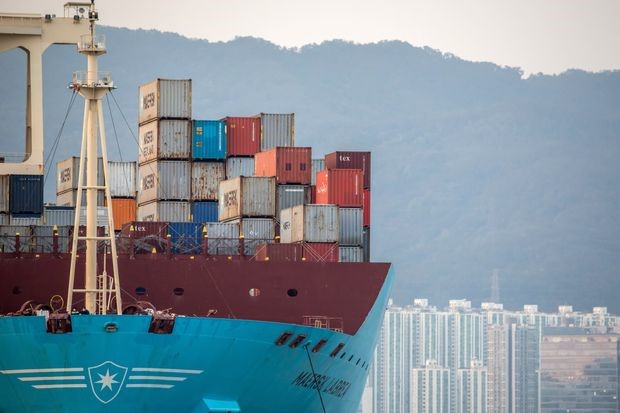
A.P. Moeller-Maersk, the world’s largest container line by capacity, saw profits soar 83% in the third quarter on recovering volumes and rising freight rates.
PHOTO: PAUL YEUNG/BLOOMBERG NEWS
Danish shipping and logistics giant A.P. Moeller-Maersk A/S expects that the global container market could expand by up to 5% in 2021 in a rebound from the pandemic-driven hit to trade in the first half of this year.
The parent of Maersk Line, the world’s largest container line by capacity, said Wednesday that trade volumes are growing again this fall as retailers and manufacturers restock depleted inventories and consumers who were hunkered down in the early months of the coronavirus pandemic resume spending.
“Right now we see volumes slightly above the same period from last year after falling off a cliff in the second quarter,” said Maersk Chief Executive Søren Skou. “A lot of the money that had previously gone into holiday travel and restaurant visits has gone to goods like flat screens and home improvement.”
Improving trade demand, along with stronger pricing and lower costs, helped push Maersk to a $927 million profit in the third quarter, an 83% improvement over the $506 million earnings in the same quarter a year ago.
The report marked the latest in a string of strong earnings reports from shipping lines that idled ships and canceled hundreds of sailings in the spring and then reaped higher rates as economies around the world unwound lockdowns aimed at stemming the spread of Covid-19.
“An unexpected recovery in demand after the second-quarter slowdown brought back all available tonnage and significantly higher prices in the short-term freight market,” said Maersk’s third-quarter revenue fell 1.4% to $9.92 billion, above the company’s own guidance of $9.9 billion, and shipping volumes fell 3.6% from a year ago.
This was more than offset by lower costs from reduced sailings, lower fuel costs and higher freight rates.
Average freight rates at Maersk were 4.4% higher than a year ago. Industrywide rates for spot-market sailings have surged 170% since January to $3,887 per box for trans-Pacific trade and are up by a third to $1,500 for business from Asia to Europe, according to the Shanghai Containerized Freight Index.
Maersk late Tuesday upgraded full-year guidance for the second time in a month. It said it now expects full-year earnings before interest, tax, depreciation and amortization of $8 billion to $8.5 billion, compared with $7.5 billion to $8 billion previously
Container operators withdrew as much as 20% of their capacity in the second quarter but container imports are flowing back into Western markets, with U.S. retailers now in a race to restock before the holiday season.
French carrier CMA CGM SA and Germany’s Hapag-Lloyd AG have also said they have seen surging demand for Asian imports from U.S. retailers such as Amazon.com Inc. and Walmart Inc. The peak season for shipping typically runs from August to early October, but this year, operators say it started in July and is still going.
“The tailwinds from rates and volumes are accelerating into the fourth quarter,” Mr. Skou said. “We now expect to deliver a fourth quarter that is stronger than the third. This is unusual and not our normal seasonality, and it has enabled us to upgrade our expectations for the full year.”
Mr. Skou said he expects the broader container market to shrink up to 5% this year and return to pre-pandemic levels next year.
Analysts warn the market will still be subject to wide swings, based on the response to efforts to fight the coronavirus.
“If the coming vaccines work and the virus is eradicated, people will again start spending for travel and going out, which means volumes will drop because the inventory will overshoot,” said Lars Jensen, chief executive of Copenhagen-based SeaIntelligence Consulting.
Source: The Walle Street Journal, November 19, 2020 | Costas Paris and Dominic Chopping